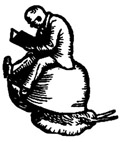|
As one who must at times estrange himself from the world at large both physically and mentally, the writer might be forgiven for sometimes envisioning himself as a Dante-like figure: at first, lost, and unsure of his place in history, but subsequently led through a deepening and increasingly torturous realm until, after overcoming a purgatory of revision where the worthy are saved, he and his work at last ecstatically emerge into the light of day, approaching in an almost sexual climax the shining presence of the perfect and almighty God. Perhaps I am alone in this feeling, but I suspect that while the metaphors may vary, the sensations encountered over the course of a creative task are not. The ecstasy of inspiration is a fantastic, but fleeting, phenomenon, and when it has passed, it is the artist's lonesome lot to refine the raw materials. This part of the creative process demands intelligence, finesse, patience, wisdom, dexterity and sympathy, and it is in this work that the artist proves his worth. God is not approached in a single breakneck sprint, but by a slow and arduous climb, and when Heaven is finally reached, one arrives, ultimately, alone.
Does the inherent solitude of art preclude cooperation amongst artists? Not necessarily, but those who practice the creative arts are often drawn to them by solitude of one form or another. The concentration and clarity demanded by a cohesive and expressive work, not to mention the refinement of the initial and subsequent efforts, often force the artist into a room apart and into the depths of self examination. For those who find solace in it, creation is an escape from the world as well as a method of recreating the world in one's own image, a manifestation of the desire for the power to affect one's surroundings. Feelings of isolation can drive one towards creation just as creation can drive one into isolation. Hearing of a community of writers who have set up a workshop, suspicions may arise. Who could produce anything of merit without solitary meditation? What if one become dependent on others' guidance or is swayed by their influence? The workshop does not replace individual effort, and while dangers like dependence exist, history has shown the benefits of creative collaboration. The idea of artistic cooperation is far from new. Though he still carried a sword after losing his sight, Milton relied on his daughters to put "Paradise Lost" on paper. Byron's handwriting left much to be desired, and so he would often submit works to Mary Shelley for transcription. While she transcribed, she would also at times revise, and Byron sometimes incorporated her changes into his final drafts. As for Mrs. Shelley herself, her most well-known work was the result of a game played with other writers to see who could come up with the scariest story. The early 20th century saw the collaboration of T.S. Eliot and Ezra Pound on a poem called "the Waste Land", and a trip to the poetry section of your local discerning bookseller should yield a copy of The Waste Land: A Facsimile and Transcript of the Original Drafts Including the Annotations of Ezra Pound, wherein one can fully appreciate the extent of Pound's revisions. There are plenty of artists who have suffered through artistic solitary confinement in order to create works of tremendous scope and power, but one cannot deny the vast impact of literary groups and friendships on our received artistic landscape. If it was not unheard of for earlier artists to collaborate on certain projects, then for what reasons might the modern artist hesitate? There are risks, of course, but there is plenty to be gained. Writing is, like all artistic forms, a matter of framing and craftsmanship. The writer is as much a laborer as the painter or the sculptor, working with a different sort of medium, but applying to a surface both her skills and a set of tools, one of which being the workshop. Once the artist believes that a piece has evolved and matured to the point where it can withstand the light of day (or at least the din of the café), it should be considered for review. The workshop is a resource one can turn to and drawn on for inspiration, criticism, instruction, and appreciation. Ideally, it is composed of a number of artists and critics, ranging from amateurs to aficionados. It is a community, dedicated not to propagating itself, but to the understanding and appreciation of literature. It is of necessity more helpful to the young and inexperienced artist than to the more practiced of the group, but the workshop remains a tool even of the experienced: there is always something to be said for a fresh perspective, and the appreciative and critical eye one develops looking at others' work can be taken back and turned to the writer's own work.
continued on page 2 > |

